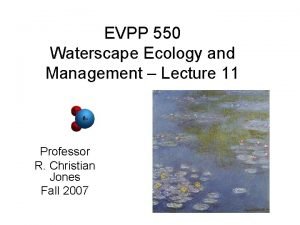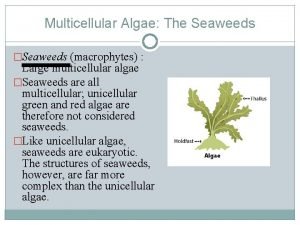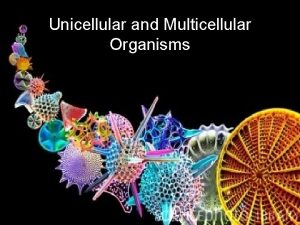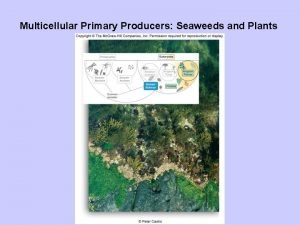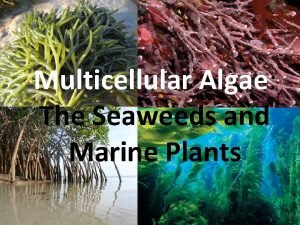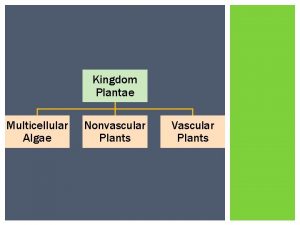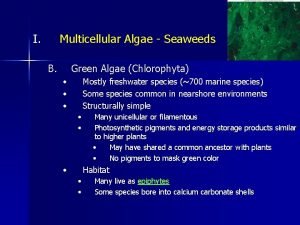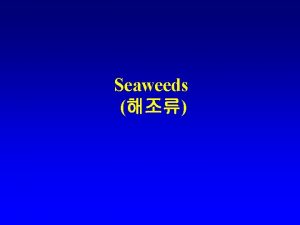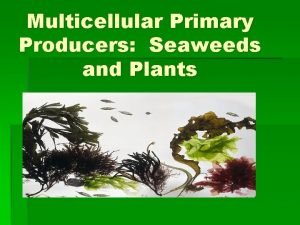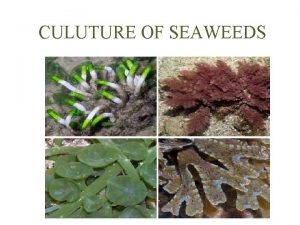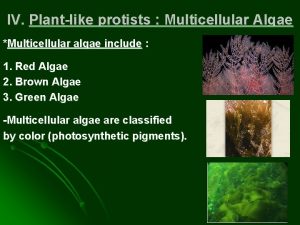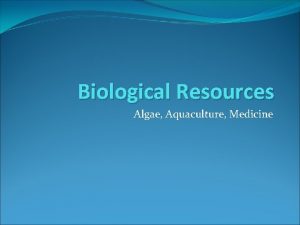Multicellular Algae The Seaweeds Seaweeds macrophytes Large multicellular










- Slides: 10

Multicellular Algae: The Seaweeds �Seaweeds (macrophytes) : Large multicellular algae �Seaweeds are all multicellular; unicellular green and red algae are therefore not considered seaweeds. �Like unicellular algae, seaweeds are eukaryotic. The structures of seaweeds, however, are far more complex than the unicellular algae.

The General Structure � Seaweeds lack true leaves, stems, and roots of plants. The complete body is known as the thallus (thin leafy sheet. ) � The leaf-like, flattered portions of the thallus of many seaweeds are known as blades. � Gas filled bladders known as pneumatocysts sometimes keep the blades close to the sea surface. � A distinct stem, the stipe originate from the blades. � The structure that looks like roots, the holdfast, attaches the thallus to the bottom.

Types of Seaweeds �Green algae: Most of green algae (phylum Chlorphyta) are restricted to freshwater and terrestrial environments 10% of 7, 000 species are marine. (Ex: Calcareous green alga, deposit calcium carbonate) �Brown algae: The color of the brown algae (phylum Heterokontophyta, class Phaeophtya) �Red algae: There are more species of marine red algae (phylum Rhodophyta), have red pigments called phycoblins.

�What are phytoplankton? Photoautotrophs adapted to life floating in open water. Intro rather than attached to some substrate. �Phytoplankton communities are surprisingly diverse. � A single plankton tow might have as many as 50 -100 species. Apparently there is relatively little competitive exclusion. (which means? ) �May be unicellular or multicellular. Sargassum is a very large and complex member of the phytoplankton. �Size is one important way to classify plankton. Unfortunately, different authors use different break-points for size classes. . . scale: Macroplankton are > 200 µm in diameter. Microplankton are 20 -200 µm (micrometers) dia. Nannoplankton are 2 -20 µm (micrometers) dia. Picoplankton are 0. 2 -2 µm (micrometers) dia The nannoplankton and picoplankton were neglected until recently, and their environmental significance is an area of active research.

�Growth rates for smaller plankton can be quite high. Some cyanobacteria are capable of doubling several times in a single day, while even in relatively slow growing organisms can double every week or two. If you want to follow population dynamics in these organisms, you have to sample frequently, or else you will miss the key events. �Phytoplankton are phylogenetically diverse, and have dramatically different physiological capabilities. To understand the community dynamics, it is necessary to track the diversity of the community. Important phytoplankton groups include cyanobacteria, cryptomonads, haptophytes, several heterokont groups, dinoflagellates, euglenoids, and green algae.

Life History Reproduction is a complex affair in the Seaweeds. Asexual reproduction is common. It may be more important than sexual reproduction in most species. WHY?

Phytoplankton � Phytoplankton always live near the surface of the sea because, like all plants, they require light for photosynthesis , the transformation of water and carbon dioxide. � Phytoplankton are quite small that they sink slowly because they don’t weigh very much and because they have a large surface area in contract with water. (slows sinking…friction)

Zooplankton � Zooplankton, the planktonic animals , are all weak swimmers, whereas phytoplankton, do not swim at all. (non-animals) � Zooplankton also occur at the surface of the sea during the day…the gelatinous zooplankton. � Zooplankton feed off of Phytoplankton, making them the second link in the marine food web. Zooplankton then get eaten by krill, fish and larger crustaceans. � In order for the zooplankton to have easy access to their food source, they need to be located near the phytoplankton. Because phytoplankton needs sunlight to photosynthesize, they must be near the surface of the water. Zooplankton also need iron in their diet.

PLANKTONs �Phytoplankton’s growth, are rapidly sometimes population explosions, ‘blooms” and “red tides” utilizing the nutrients upwelled in winter. (Harmful Algal Blooms) �In the spring, zooplankton populations begin to expand, grazing upon the phytoplankton, the top carnivores, the pelagic fish, spawn, making larval fish that feed in turn on zooplankton. �In the summer the annual cycle repeats.

Food Chain
